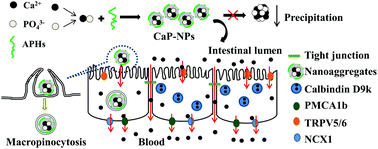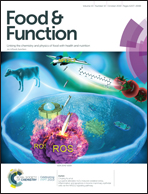Formation of calcium phosphate nanoparticles mediated by animal protein hydrolysates enhances calcium absorption by murine small intestine ex vivo†
Abstract
Animal protein intake appears to exert beneficial effects on bone health. Here, animal protein hydrolysates (APHs) originated from casein, whey protein isolate, egg white, myofibrillar protein, sarcoplasmic protein and gelatin were shown to prevent calcium phosphate (CaP) precipitation by increasing the surface charge and slowing the crystal growth of CaP particles. Dynamic light scattering, transmission electron microscopy and energy-dispersive X-ray analysis revealed the APH-mediated formation of irregularly shaped secondary nanoparticles aggregated from rather small amorphous CaP nanoclusters. APHs effectively counteracted the detrimental effect of the low calcium-to-phosphorus ratio on calcium transportation across ligated murine ileum, and by treating with NaN3, amiloride and low temperature, macropinocytosis was found to involve the intestinal uptake of CaP nanoparticles. APHs of meat origin had weaker potential to increase CaP solubility and ileal calcium transportation than those of dairy and egg origins. Overall, our study reports a novel mechanism for animal protein intake to promote intestinal calcium absorption.



 Please wait while we load your content...
Please wait while we load your content...